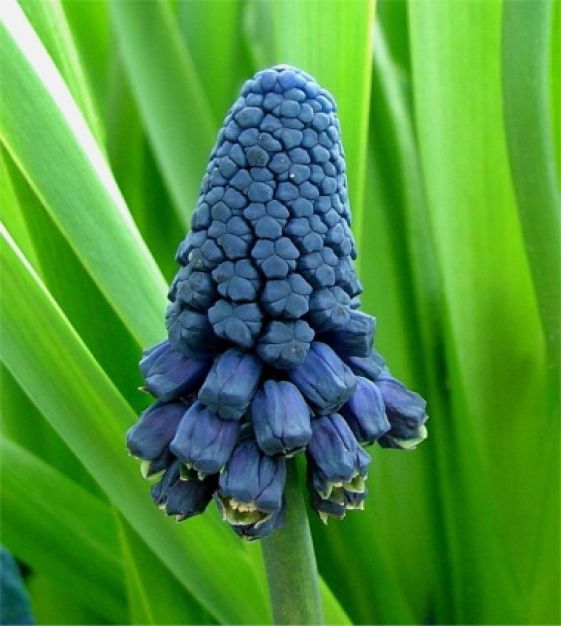-
- 20%-Off Website Specials
- New for 2024!
- Tulips
- Narcissi
- Allium
- Anemone blanda
- Brodiaea
- Camassia
- Chionodoxa
- Corydalis
- Crocus
- Eranthis
- Eremurus
- Erythronium
- Fritillaria
- Galanthus
- Geranium
- Gladiolus
- Hyacinths
- Hyacinthoides
- Ipheion uniflorum
- Dutch Iris
- Rock Garden Iris
- Ixiolirion
- Leucojum Aestivum
- Muscari
- Ornithogalum
- Oxalis
- Puschkinia
- Scilla
- Lilies
- Peonies
- Tender Bulbs
- Anemone Giants
- Tecolote Ranunculus
- Freesias
- Paperwhites
- Amaryllis
Muscari paradoxum
Also known as Bellevalia pycnantha, this 1884 heirloom yields conical racemes of densely compacted, pale to deep blue florets with a greenish-yellow hue above ample foliage clumps. Not as hardy as other Muscari, it would benefit from a 2" layer of mulch after the surface of the ground freezes for protection from winter temperature spikes. Bulb size: 6 cm/up. Full to partial sunlight. Bloom time in horticultural zone 5: April/May. Plant 5" deep and 3" to 4" apart. HZ: 5-8. Height: 7" to 8".
Muscari are The Art & Soul of Spring.
Muscari Horticultural Tips
Muscari are The Art & Soul of Spring.
Muscari Horticultural Tips
- Information
Muscari
Commonly known as Blue Grape Hyacinths for their form and sweet, grapey fragrance, deer- and rodent-resistant Muscari naturalize well with a succession of composite flowering stems. They are wonderful planted in thick borders along garden beds, in front of, or under, Narcissi and in rivers meandering through dappled woodlands. The name Muscari derives from the work musk, due to its slight fragrance. Deer- and rodent-resistant Muscari naturalize readily in well-draining soil and in full to partial sunlight. They make good cut flowers too. You’ll need about nine bulbs per square foot. Muscari also force well. It is common for Muscari to grow foliage in the fall: just ignore it and do not mulch until the ground surface freezes. Top size bulbs. Height: 4" to 12" depending on the variety. Bloom time: variable, April through May depending on the variety. Plant 5" deep and 3" to 4" apart. Horticultural zones 4-8.
Muscari are The Art & Soul of Spring.
Muscari Horticultural Tips
Commonly known as Blue Grape Hyacinths for their form and sweet, grapey fragrance, deer- and rodent-resistant Muscari naturalize well with a succession of composite flowering stems. They are wonderful planted in thick borders along garden beds, in front of, or under, Narcissi and in rivers meandering through dappled woodlands. The name Muscari derives from the work musk, due to its slight fragrance. Deer- and rodent-resistant Muscari naturalize readily in well-draining soil and in full to partial sunlight. They make good cut flowers too. You’ll need about nine bulbs per square foot. Muscari also force well. It is common for Muscari to grow foliage in the fall: just ignore it and do not mulch until the ground surface freezes. Top size bulbs. Height: 4" to 12" depending on the variety. Bloom time: variable, April through May depending on the variety. Plant 5" deep and 3" to 4" apart. Horticultural zones 4-8.
Muscari are The Art & Soul of Spring.
Muscari Horticultural Tips
Muscari
Commonly known as Blue Grape Hyacinths for their form and sweet, grapey fragrance, deer- and rodent-resistant Muscari naturalize well with a succession of composite flowering stems. They are wonderful planted in thick borders along garden beds, in front of, or under, Narcissi and in rivers meandering through dappled woodlands. The name Muscari derives from the work musk, due to its slight fragrance. Deer- and rodent-resistant Muscari naturalize readily in well-draining soil and in full to partial sunlight. They make good cut flowers too. You’ll need about nine bulbs per square foot. Muscari also force well. It is common for Muscari to grow foliage in the fall: just ignore it and do not mulch until the ground surface freezes. Top size bulbs. Height: 4" to 12" depending on the variety. Bloom time: variable, April through May depending on the variety. Plant 5" deep and 3" to 4" apart. Horticultural zones 4-8.
Muscari are The Art & Soul of Spring.
Muscari Horticultural Tips
Commonly known as Blue Grape Hyacinths for their form and sweet, grapey fragrance, deer- and rodent-resistant Muscari naturalize well with a succession of composite flowering stems. They are wonderful planted in thick borders along garden beds, in front of, or under, Narcissi and in rivers meandering through dappled woodlands. The name Muscari derives from the work musk, due to its slight fragrance. Deer- and rodent-resistant Muscari naturalize readily in well-draining soil and in full to partial sunlight. They make good cut flowers too. You’ll need about nine bulbs per square foot. Muscari also force well. It is common for Muscari to grow foliage in the fall: just ignore it and do not mulch until the ground surface freezes. Top size bulbs. Height: 4" to 12" depending on the variety. Bloom time: variable, April through May depending on the variety. Plant 5" deep and 3" to 4" apart. Horticultural zones 4-8.
Muscari are The Art & Soul of Spring.
Muscari Horticultural Tips





